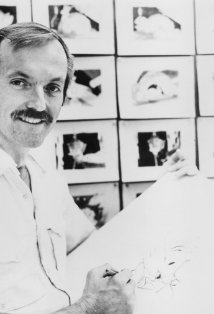Donald Virgil Bluth (born September 13, 1937) is an American animator and independent studio owner.
He was born in El Paso, Texas and became one of the chief animators at Warner Bros. Animation. Along with fellow animators Gary Goldman and John Pomeroy, he set out in 1979 to start his own animation studio, Don Bluth Productions. His style is rougher and more lively than that of Warner Bros. films, and his films tend to have a mystical element to them.
Teaming up with Rick Dyer, Bluth created the groundbreaking arcade game Dragon's Lair (1983), which let the player control a cartoon-animated character on screen (whose adventures were played off a laserdisc). This was followed in 1984 by Space Ace, a science-fiction game based on the same technology, but which gave the player a choice of different routes to take through the story; and Dragon's Lair II: Time Warp, a sequel which was very rare in arcades.
His next three films, An American Tail (1986), The Land Before Time (1988) and All Dogs Go to Heaven (1989), did well in theaters and became animation classics. Each movie launched a line of sequels, most of which were released direct-to-video, and none of which Bluth worked on. But by the end of the decade and through the 1990s, Bluth films such as Rock-A-Doodle, the 1992s films such as Thumbelina and A Troll in Central Park, the 1995 film The Pebble and the Penguin had dropped significantly when it came to box office returns.
Bluth scored another hit with Anastasia (1997) + Bartok the Magnificent (1999) which grossed US$140 million worldwide in part because it used well-known Hollywood stars as its voice talent and stuck closer to long-proven Disney formulas: a sassy and resourceful princess driven to become more than she is, a cruel and conniving villain who uses dark magic, a handsome and endearing love interest, and a comic-relief sidekick. However, this was followed by the financially-disastrous Titan A.E. in 2000.
A recent attempt to capitalize on Dragon's Lair nostalgia by releasing the computer game Dragon's Lair 3D: Return to the Lair (2003) was unsuccessful; the game was panned by critics as being flat and uninteresting, despite groundbreaking cel-shading techniques that lent the game a hand-animated feel. Don Bluth and Gary Goldman are currently seeking funding for a film version of Dragon's Lair.
In 2004, Bluth produced an animated scene for the music video "Mary", by the Scissor Sisters. The band contacted Bluth after having recalled fond memories of the sequence from Xanadu.
Bluth has also authored a series of books for students of animation: 2004's The Art of Storyboard, and 2005's The Art of Animation Drawing. Additional books are planned.
Trivia[]
- In the 1990s, Bluth began screening his films to test audiences. His film Thumbelina tested significantly better with audiences when it was screened with a Warner Bros. logo at the start.
- Bluth is a member of The Church of Jesus Christ of Latter-day Saints. the secet of nimh (rainbow screen partners II)
- an american tail (rainbow sceen partners III
- the pebble and the penguin (rainbow screen partners IIXV)
- the land before time (rainbow screen partners IXV)
- don bluth televison animation
- universal studios
- an all dogs christmas carol
- pete's dragon
- mickey's house of villains
External links[]
- Official site, DonBluth.com
- The IMDb entry on Bluth
- Detailed Info on Don Bluth's Films including a biography
- The Dot Eaters entry on Bluth and the development of Dragon's Lair
- Digital Press interview with Dragon's Lair animator Don Bluth
Video games: Dragon's Lair (1983) • Space Ace (1984) • Dragon's Lair II: Time Warp (1991)
Animated films: The Small One (1978) • Banjo the Woodpile Cat (1979) • The Secret of NIMH (1982) • An American Tail (1986) • The Land Before Time (1988) • All Dogs Go to Heaven (1989) • Rock-a-Doodle (1990) • Thumbelina (1993) • A Troll in Central Park (1994) • The Pebble and the Penguin (1995) • Anastasia (1997) • Bartok the Magnificent (1999) • Titan A.E. (2000)
Related articles: Sullivan Bluth Studios • Fox Animation Studios

